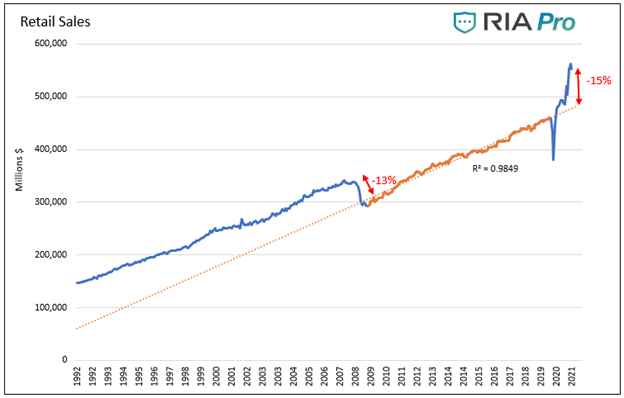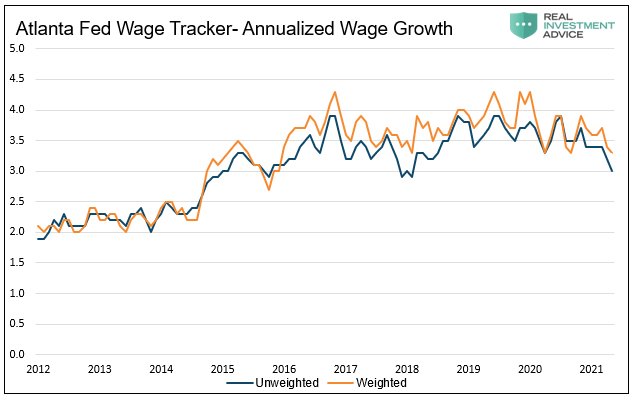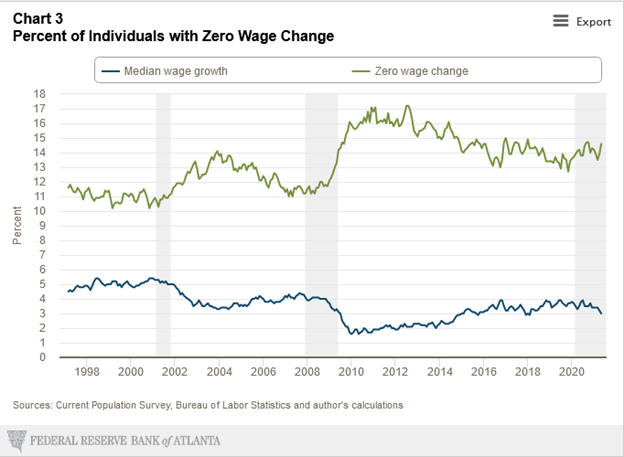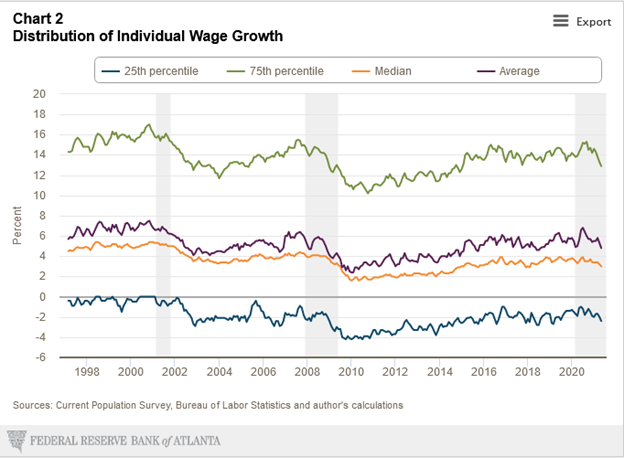Asia stocks dither ahead of Fed meeting; Japan Q3 GDP in focus
- “To me, a wise and humane policy is occasionally to let inflation rise even when inflation is running above target.” – Janet Yellen
- “To me, the weather is perfect when it’s 75 degrees.”
Both statements have some truth to them but severely lack context.
Even if it is 75 degrees, can I call it a perfect day if a hurricane is bearing down with torrential downpours and 150 miles per hour winds?
Letting inflation rise “above target” may have some benefit, but the rate at which incomes are changing versus inflation and its effect on confidence is far from inconsequential.
Yellen’s comments align with most Fed members who wish to see inflation run “hot.”
In this article, we explore the consumer’s plight and whether letting inflation run “hot” is a wise and humane way to keep the economic recovery rolling.
What’s Supporting the Economic Recovery
The robust economic recovery is in part the result of nearly $5 trillion in deficit spending.
To grasp how the government supported the economy, consider the graph below. The orange line is total personal income. After the second set of direct payments to citizens went out in March, personal income was 25% more than before the pandemic. The blue line shows organic income, or that earned solely through employers. The difference, the gray area, is payments from the government, known as transfer payments. These direct benefits represented nearly a third of income on multiple occasions over the last year.
Personal consumption represents nearly two-thirds of economic activity (GDP). Over the last six months, consumption was significantly boosted by stimulus programs. Further, the government allowing forbearance of rent, mortgage, student loan, and utility payments provided many with additional money to spend.
Resulting from surging income and reduced liabilities, retail sales are running about 15% above the trend of the prior decade. For historical recessionary context, consider retail sales fell by about 13% from its trend during the 2008 recession.
With the economy reopening quickly, the government is handing the recovery baton to consumers. As such, the strength of wages and employment, the means with which we consume, are critical if the recovery is to continue without enormous support from Uncle Sam.
Atlanta Fed Wage Tracker
The data and graphs in this section and other informative data are from the Atlanta Fed Wage Tracker website.
When wages rise, consumers feel more confident in their financial standing and are more willing to spend. Consumer confidence is vital for the continuation of economic recovery. The data and graphs highlight recent wage trends allowing us to gauge potential changes in consumer confidence as we advance.
The first graph below shows wage growth was running in a 3.5-4.0% range for a few years before 2020. Since the pandemic, wage growth has been gradually declining.
Despite declining wage growth in 2020, wage growth outpaced CPI by around 2%, as shown below. That was because inflation was running at a below-average 1.3% rate. Unfortunately, the real (after inflation) wage growth from 2020 was erased. In 2021 CPI is running at a 5.4% annualized rate, dwarfing wage growth.
The following graph shows wage growth declined in 2020 for all categories except paid hourly workers. The trend continues in 2021 as all classifications are falling.
The takeaway from the graphs above is that wage growth is falling, and inflation is picking up. As a result, as shown in the first bar chart, real wages are falling by about 2% this year.
Chart 3 below shows the percentage of those not receiving pay raises has been up ticking since 2020, after trending lower for the prior decade. Median wage growth is also falling, like the average wage growth shown above.
Chart 2 below shows that average wage growth is falling at all income levels.
Lastly, we add one more important consideration. The series of graphs above solely focus on those with jobs. Left out of the data are nearly 10 million people who have lost jobs in the last year and a half
Taking Off the Training Wheels
Like riding a bike for the first time, confidence is imperative once your teacher lets go and pushes you forward. Confidence, along with balance, allows the rider to peddle forward and at increasing speeds. New bike riders often lack confidence in their abilities and fall many times before speeding ahead.
The government is weaning consumers from critical support at a rapid rate. There are no more direct checks, unemployment benefits are expiring, and forbearance rules are ending. Consumers must start peddling at a fast pace to keep the economy going. Like riding a bike, confidence will play a vital role if the handoff from the government is to be successful.
The University of Michigan Consumer Sentiment survey, shown below, is improving but shows confidence is not what it was.
The Atlanta Fed graphs show wages are shrinking on a real basis. Recent BLS data confirms the message. Real average weekly and hourly earnings fell 2.2% and 2.8%, respectively on a year-over-year basis.
Is now the time for the Fed to promote policies that effectively reduce wages via inflation? We find it hard to believe consumers will be gung-ho about spending when their wages do not go as far as they used to.
Back to Janet Yellen’s quote. Is more inflation wise at such a precarious spot in the recovery? To paraphrase, is damaging consumer sentiment in our best interest?
Is Inflation Humane?
As far as her characterization of more inflation being humane, we have choice words for Mrs. Yellen.
In Two Pins Threatening Multiple Asset Bubbles, we quantified how low-wage workers are more affected by rising inflation. To wit: “Only accounting for food and housing, two necessities, the lowest income classes saw their annual expenses rise by 6.05%. The highest income classes saw their expenses rise by 2.10%.”
There is nothing humane about reducing purchasing power for a large majority of citizens. What can we possibly hope to gain by reducing the economic standing of the many for the benefit of a few? Further, growing wealth inequality does not bolster confidence, quite the opposite in fact.
Summary
The Atlanta Fed and BLS show wages are failing to keep up with inflation. While nominal economic data may improve due to the effects of higher prices, inflation-adjusted data, which is the reality we all live by, does not benefit.
It is now common to hear people complain about sharply rising prices. Social and traditional media fan the flames as they increasingly bring inflation to light. While some consumers may take inflation with a grain of salt, many others are likely to become more frugal.
Consumer confidence is vital to keep recovery rolling.
So, with proper context, do you believe more inflation is wise or humane?








